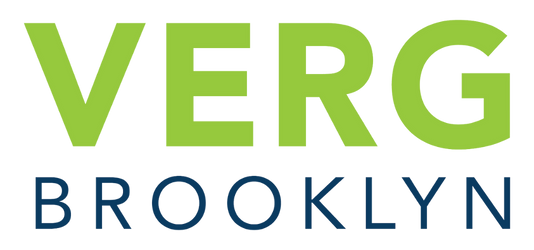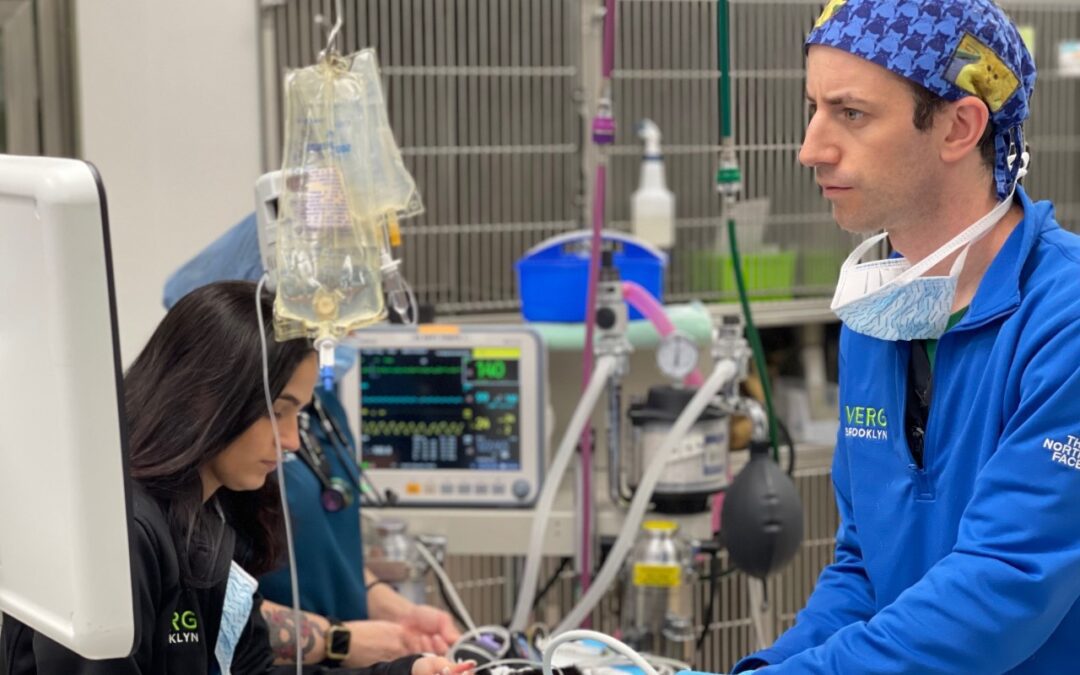A Comprehensive Guide to Veterinary Anesthesia & Pain Management at VERG Brooklyn: Ensuring the Well-being of Our Pets
As pet owners, we always want what is best for our furry companions, especially when they need medical care or undergo surgical procedures. Veterinary anesthesia and pain management specialists play a crucial role in ensuring the comfort and well-being of our beloved pets during these times. Veterinary anesthesia refers to the administration of anesthesia to animals during surgical or medical procedures. It involves various medications and techniques to induce unconsciousness, prevent pain, maintain vital signs, minimize stress and discomfort, and ensure the animal’s safety and well-being throughout the medical procedure. This blog provides a comprehensive guide to veterinary anesthesia, exploring its importance, techniques, monitoring, and safety considerations.
Comprehensive Evaluation
Before administering anesthesia, our anesthesia specialists conduct a comprehensive evaluation of your pet’s health. They review your pet’s medical history, perform a thorough physical examination including blood work, and may recommend additional diagnostic tests if needed. This evaluation helps identify any underlying health conditions or potential risks, allowing them to customize an anesthesia plan that minimizes potential complications. By tailoring the anesthesia plan to each animal, we ensure the safest and most effective anesthesia protocol for your pet, minimizing risks and maximizing their comfort.
The Significance of Veterinary Anesthesia
Animals, like humans, experience pain, stress, and anxiety during medical procedures. Veterinary anesthesia is essential for alleviating their discomfort, preventing pain, and facilitating successful interventions. By inducing a state of unconsciousness, anesthesia allows veterinarians to perform surgeries, and diagnostic tests without causing distress or compromising patient and medical staff safety.
During surgery, anesthesia allows veterinarians to have better access to the surgical site. For advanced imaging techniques like magnetic resonance imaging (MRI) or computed tomography (CT) scans, anesthesia allows our team to obtain accurate and detailed images by allowing the pet patient to remain still and cooperative. Ultimately, anesthesia enables our veterinarians, techs, and assistants to work efficiently and perform procedures in a controlled environment. With the animal safely anesthetized, procedures can be completed with precision and reduced time, minimizing the risk of complications.
Veterinary Anesthesia Management at VERG Brooklyn
The administration of veterinary anesthesia requires specialized knowledge and skills to tailor the anesthesia plan to the animal’s specific needs. Factors such as species, age, overall health, and the nature of the procedure being performed all influence the choice of anesthetic drugs and techniques. At VERG, we have our very own veterinary anesthesiologist – Dr. Benjamin Gingold. Dr. Benjamin Gingold attended veterinary school at the University of Queensland, Australia where he developed a keen interest in anesthesia, analgesia, and critical care medicine. His interests and expertise resulted in new techniques to target pain better and lessen the doses of opioids and gas anesthesia given to our pet patient.
Motor Sparing Local Nerve Blocks for Stifle Surgery
At VERG Brooklyn, Dr. Gingold developed Motor Sparing Local Nerve Blocks for Stifle Surgery to reduce hospitalization time, reduce opioid use, and facilitate rehabilitation and earlier return to function. This has become the gold standard of anesthesia in humans and VERG Brooklyn was the first and one of the few animal hospitals to provide this level of care to our pet patients.
Motor sparing local nerve block for stifle surgery in dogs involves the use of anesthesia or analgesia techniques that target specific nerves in the hind limb to provide pain relief during the procedure while preserving motor function. This approach aims to minimize pain and discomfort for the dog while allowing them to maintain muscle strength and mobility in the affected limb. It is a valuable technique in veterinary surgery to improve postoperative recovery and overall patient comfort.
Tailoring Anesthesia to Individual Needs
Administering anesthesia to animals requires a personalized approach. At VERG Brooklyn, several factors are taken into consideration to create a customized anesthesia plan that optimizes safety, efficacy, and patient comfort. Here are some key considerations in tailoring anesthesia to individual needs:
Species and Breed: Different species and breeds have unique physiological and anatomical characteristics that can influence the choice of anesthetic drugs and techniques. For example, brachycephalic (short-faced) breeds may be more prone to respiratory issues, requiring careful selection of anesthesia to maintain adequate oxygenation.
Age: Age plays a role in determining the appropriate anesthesia plan. Young animals may have different anesthesia requirements due to their developing physiology, while geriatric patients may have underlying health conditions that need to be considered.
Health Status: The overall health of the animal is crucial in determining the anesthesia approach. Pre-anesthetic evaluations, including a thorough physical examination and laboratory tests, help identify any underlying conditions that may affect the choice of anesthesia or require additional precautions.
Procedure Type: The nature of the procedure being performed influences the anesthesia plan. Minor procedures may only require sedation and local anesthesia, while major surgeries may necessitate general anesthesia. The duration of the procedure is also considered when selecting appropriate anesthetic drugs and monitoring techniques.
Pain Management: Pain management is an integral part of anesthesia planning. Different analgesic medications and techniques, such as local anesthetics or opioid medications, may be incorporated to ensure adequate pain relief during and after the procedure.
Individual Sensitivity: Animals may have individual variations in their response to anesthesia. Some may be more sensitive to certain drugs or require higher dosages for the desired effect. Close monitoring during anesthesia allows adjustments to be made based on the individual patient’s response.
Anesthetic Techniques
- a) Inhalation Anesthesia: Inhalation agents delivered via masks or endotracheal tubes are commonly used in veterinary practice including here at VERG. These agents include isoflurane, sevoflurane, and desflurane, which provide a smooth induction and recovery, precise control over anesthesia depth, and quick clearance from the body.
- b) Intravenous Anesthesia: Intravenous drugs, such as propofol and opioids, are often used for induction and maintenance of anesthesia. These medications offer rapid onset and easy titration, enabling our veterinary team to adjust the anesthesia depth as needed.
Anesthesia Monitoring
To ensure the safety of animals during anesthesia, continuous monitoring of vital signs is crucial. Advanced monitoring equipment, including pulse oximeters, capnography, blood pressure monitors, and ECGs, allow our veterinarians and technicians to assess parameters such as heart rate, blood pressure, respiratory rate, oxygenation, and carbon dioxide levels. By continuously assessing your pet’s condition throughout the procedure, our specialists can make adjustments as necessary, maintaining optimal anesthesia levels and pain control.
Safety Considerations and Risks
While veterinary anesthesia has significantly evolved, as with any medical procedure, it carries inherent risks. Potential complications include adverse reactions to medications, respiratory issues, cardiovascular instability, and post-anesthetic recovery problems. However, the vigilant monitoring, expertise of our veterinary anesthesiologist and techs, and comprehensive pre-anesthetic assessments significantly minimize these risks.
The Importance of Post-Anesthetic Care
The recovery period after anesthesia is critical for animals. Adequate pain management, a warm and quiet recovery environment, and careful observation are essential during this phase. At our hospital, the veterinarians administer pain relief medications, ensure proper hydration, and monitor vital signs until the animal is fully awake and alert.
Veterinary anesthesia is an integral part of ensuring the well-being of our animal companions during surgical and medical procedures. By tailoring anesthesia plans to individual needs, utilizing various techniques, and employing advanced monitoring, our veterinary professionals strive to provide safe and effective anesthesia experiences. Trusting your pet’s anesthesia and pain management needs to these specialists at VERG Brooklyn will give you peace of mind, knowing your beloved companion is in capable and caring hands.

